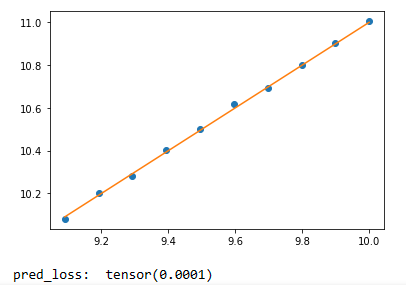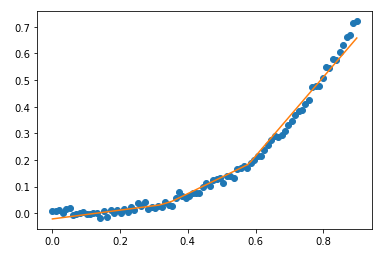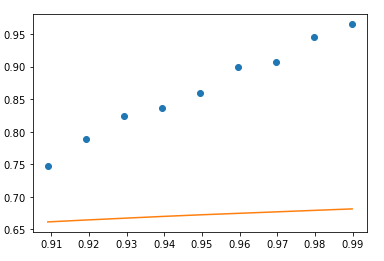神经网络拟合函数
1.准备数据
导入需要使用的第三方库
import torch
import numpy as np
import random
import matplotlib.pyplot as plt
import torch.nn as nn
import torch.functional as func根据给定的w、b生成训练集和测试集(按9:1划分)
def gen_data(w, b, num):
x = torch.linspace(0, 10, num, dtype=torch.float32).reshape(-1, 1)
print(x.shape)
y = torch.matmul(x, w) + b
y += torch.normal(0, 0.01, y.shape)
print(y.shape)
train_x = x[: num * 9 // 10]
train_y = y[: num * 9 // 10]
test_x = x[num * 9 // 10 :]
test_y = y[num * 9 // 10 :]
return train_x, train_y, test_x, test_y注意这里为什么要
reshape,主要原因是要进行矩阵乘法,需要将向量转化成二维张量。
train_x, train_y, test_x, test_y = gen_data(torch.tensor([1.0]).reshape(1,1), 1.0, 100)2.建立模型
拟合一次函数
class model(nn.Module):
def __init__(self):
super().__init__()
self.hidden = nn.Linear(1, 1)
def forward(self, x):
x = self.hidden(x)
return x实现forward方法即可
3.训练模型
输入参数很简单,不用解释了
def train(train_x, train_y, epochs, opt, loss_func, net):
for epoch in range(epochs):
pred = net(train_x)
loss = loss_func(pred, train_y)
opt.zero_grad()
loss.backward()
opt.step()
if epoch % 500 == 0:
print("loss: ", loss)
return list(net.parameters())4.设置超参数
loss_func = torch.nn.MSELoss()
opt = torch.optim.SGD(net.parameters(), lr = 0.01)
epochs = 10000这里选择均方误差损失函数,优化器选择随机梯度下降法,训练轮次为10000
5.开始训练
net = model()
train(train_x, train_y, epochs, opt, loss_func, net)6.预测结果
def prediction(test_x, test_y, net):
pred = net(test_x)
with torch.no_grad():
loss = loss_func(pred, test_y)
plt.plot(test_x.numpy(), test_y.numpy(), 'o')
plt.plot(test_x.numpy(), pred.detach().numpy())
plt.show()
print("pred_loss: ", loss)prediction(test_x, test_y, net)
上图可以看出,误差已经很小了
7.拟合三次多项式函数
生成数据集
def gen_data(a, b, c, d, num):
x = torch.linspace(0, 1, num, dtype=torch.float32).reshape(-1, 1)
y = torch.matmul(x ** 3, a) + torch.matmul(x ** 2, b) + torch.matmul(x, c) + d
y += torch.normal(0, 0.01, y.shape)
plt.plot(x.numpy(), y.numpy(), 'o')
plt.show()
train_x = x[: num * 9 // 10]
train_y = y[: num * 9 // 10]
test_x = x[num * 9 // 10 :]
test_y = y[num * 9 // 10 :]
return train_x, train_y, test_x, test_y可以利用Sequential创建神经网络
net = nn.Sequential(nn.Linear(1,5),
nn.ReLU(),
nn.Linear(5, 10),
nn.ReLU(),
nn.Linear(10, 5),
nn.ReLU(),
nn.Linear(5, 1)
)拟合结果如下,图一是对训练数据的拟合效果,图二是对测试数据的拟合效果


可以看出,结果应该是有一些过拟合的,可以通过一些优化方法来减少过拟合的影响



